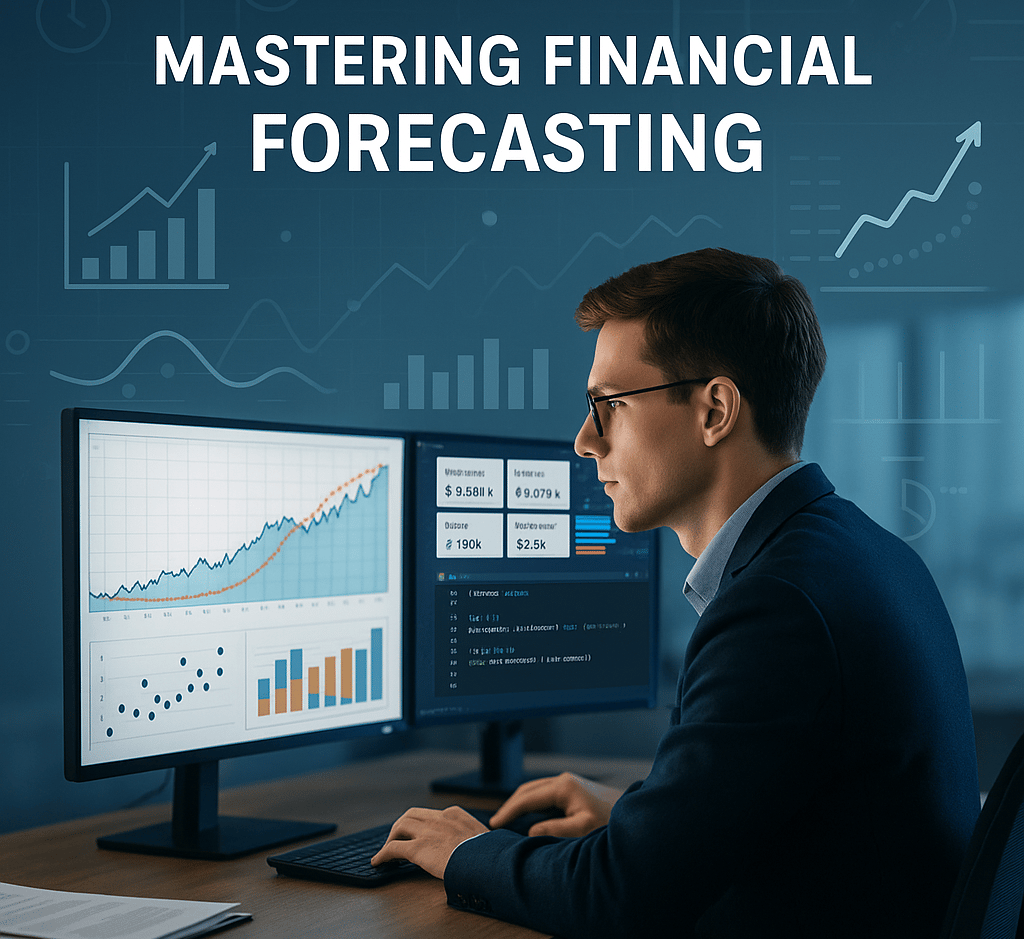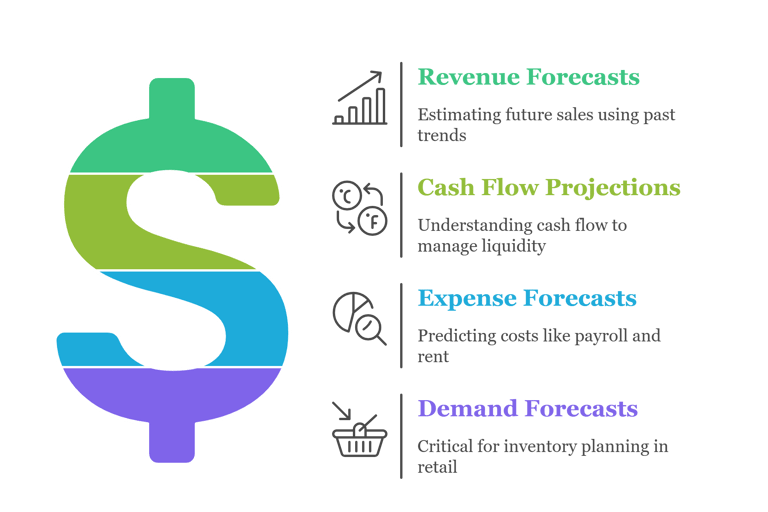Mastering Financial Forecasting: Top Tools and Techniques You Should Learn
Financial forecasting has evolved from static Excel-based planning into an agile, data-driven discipline thanks to modern tools and techniques. As organizations face increasing market volatility and complexity, forecasting has shifted from an annual spreadsheet process to real time predictive modeling.
Rakesh Arya
8/3/20257 min read


Financial forecasting has evolved from static Excel-based planning into an agile, data-driven discipline thanks to modern tools and techniques. As organizations face increasing market volatility and complexity, forecasting has shifted from an annual spreadsheet process to real‑time predictive modeling.
This shift impacts not just FP&A analysts, but finance leaders across the board—controllers, treasurers, and finance business partners alike.
In this blog, we explore core forecasting methods, highlight essential tools like Excel, Power BI, SQL, and Python, and showcase how real businesses are using these to forecast smarter—and faster.
1. What Is Financial Forecasting?
Financial forecasting refers to predicting future financial outcomes—such as revenue, expenses, or cash flow—based on historical data and assumptions.
Types of Forecasts
These forecasts help business leaders make informed decisions about budgeting, investment, hiring, and strategic direction.


Forecasting vs. Budgeting vs. Planning
Budgeting is forward-looking allocation for a fixed period.
Forecasting is dynamic and data-centric, often updated frequently (monthly or quarterly).
Planning involves scenario modeling—evaluating “what if” situations to inform long-term strategy.
2. Importance of Forecasting in Today’s Business Environment
Accurate forecasting helps organizations stay one step ahead of market shifts. It supports:
Data-driven decision-making, coordinating investments with predicted demand.
Resource planning, helping businesses avoid overstaffing or cash crunches.
Agility, adapting quickly when assumptions deviate from reality.
Real-world failures in forecasting—especially during economic shocks—underscore its importance. Conversely, companies that forecast effectively tend to outperform peers, reducing inefficiencies and anticipating risk.
3. Common Forecasting Techniques
Historical Trend Analysis
Using past data to extrapolate future values—suitable for relatively stable lines of business.
Time Series Forecasting
Models like moving average, ARIMA, or Facebook Prophet analyze seasonality, trend, and autocorrelation.
Example: LinkedIn built “Greykite”, a Python-based forecasting system, to generate interpretable, accurate forecasts for business planning across product metrics and resource allocation (source https://arxiv.org/abs/2207.07788?utm_source=chatgpt.com ).
Regression-Based Forecasting
Forecasting sales or expense trends by linking outcomes to key drivers—such as marketing spend, headcount, or regional activity.
Driver-Based Forecasting
Models that isolate operational drivers (like unit volume or price per unit) and build forecasts based on these underlying metrics.
Scenario Planning & Sensitivity Analysis
Running offensive, baseline, and defensive scenarios to understand financial outcomes under different conditions. This is critical during uncertainty.
Ensemble & Rolling Forecasts
Combining multiple models and updating forecasts as fresh data comes in—improving accuracy and responsiveness.
These methods are not mutually exclusive. Forward-thinking finance teams use combinations depending on data quality, business structure, and forecasting purpose.
4. Top Tools for Financial Forecasting
The effectiveness of a financial forecast often depends not just on the method used, but on the tools that support it. Over the years, forecasting has moved beyond manual spreadsheet models to more dynamic, automated, and intelligent platforms. Below are the key tools modern finance teams rely on, along with examples of how they are used in the industry.
Excel: Still the Foundation
Despite the rise of advanced platforms, Excel remains one of the most widely used forecasting tools. Its flexibility and familiarity make it suitable for building base models, performing sensitivity analysis, and applying what-if scenarios.
Example: Many small and mid-sized businesses still rely on Excel to build revenue and expense forecasts, particularly when integrated with add-ins like Solver, Power Query, or external data connectors.
However, Excel models are harder to maintain at scale and lack automation and collaboration features required in larger enterprises.
Power BI: Visual Forecasting and What-If Analysis
Power BI is increasingly being used in finance for visualizing forecasts and enabling interactive scenario planning. It allows teams to track actuals vs. forecasts, visualize trends, and use built-in forecasting features to make projections.
Example: A consumer electronics company uses Power BI to monitor real-time sales trends across regions. Their forecasting dashboard includes rolling revenue forecasts with adjustable assumptions and what-if parameters for pricing changes and promotional spend.
Python: Forecasting with Flexibility and Automation
Python is a powerful tool for building robust and scalable forecasting models. It supports time series analysis using libraries like statsmodels, prophet, and scikit-learn, and allows automation of recurring forecasts.
Example: LinkedIn uses its own open-source forecasting library, Greykite, built in Python, to forecast key performance indicators across its business units. Python also enables automation of end-to-end workflows—from data cleaning to model evaluation to dashboard export.
For finance professionals, learning basic Python can significantly expand forecasting capabilities, especially for complex or high-volume data environments.
SQL: Preparing and Querying Forecast Data
Forecasting is only as good as the data that feeds it. SQL is essential for pulling historical data from databases, transforming raw data into structured formats, and supporting real-time forecasting dashboards.
Example: A financial planning team at a SaaS company uses SQL to extract daily bookings and churn data, which is then fed into Python-based forecasting models to predict monthly recurring revenue.
AI/ML Platforms: Scalable Forecasting with Intelligence
Platforms like Google Cloud’s AutoML, Amazon Forecast, or Azure ML allow finance teams to build machine learning models without deep coding. These tools can automatically select the best model based on the data, and scale quickly for enterprise-wide forecasting needs.
Example: A retail chain used Amazon Forecast to project product demand across 500+ stores. By integrating historical sales, promotions, and holidays, the company achieved a 20 percent improvement in forecast accuracy compared to spreadsheet models.
Generative AI: Narrative Generation and Report Automation
While not used for calculating forecasts, generative AI tools like ChatGPT or Microsoft Copilot help streamline commentary writing, executive summaries, and variance explanations—saving hours of manual effort.
Example: A financial controller uses Copilot to generate initial drafts of month-end reporting packs, including explanations for budget vs. actual variances, based on forecast data from Power BI.
Together, these tools are reshaping how finance professionals interact with data, improve forecast accuracy, and communicate insights to the business.
5. Real-World Forecasting Use Cases
Financial forecasting is not a one-size-fits-all process. Different industries face different variables, risks, and business drivers. That’s why forecasting techniques and tools are adapted to match each company’s operations. Below are several examples of how organizations apply forecasting in the real world.
Revenue Forecasting in SaaS Companies
SaaS (Software-as-a-Service) companies often rely on recurring revenue models, which make forecasting slightly more predictable—yet complex due to churn, upgrades, and expansions.
Example: A SaaS firm forecasts Monthly Recurring Revenue (MRR) by combining historical subscription data, customer churn rates, and pipeline data from the sales CRM. SQL is used to extract user data, while Python models predict MRR under best- and worst-case sales performance.
Forecasting accuracy here helps the company align hiring plans, capital allocation, and product investments.
Cash Flow Forecasting in Manufacturing
Manufacturers often deal with long procurement cycles, varying payment terms, and capital-intensive operations. Forecasting cash flow helps them avoid liquidity shortages and manage supplier relationships.
Example: A mid-sized manufacturing company uses Power BI integrated with SAP to build a rolling 13-week cash flow forecast. The dashboard pulls live bank feeds and accounts receivable data, allowing treasury teams to adjust borrowing lines or schedule vendor payments proactively.
Demand Forecasting in Retail and E-commerce
Retailers rely heavily on accurate demand forecasts to manage inventory, pricing, and logistics—especially during high-volume seasons like holidays or sales campaigns.
Example: A global fashion retailer uses machine learning models in Python to forecast daily demand by product and location. These forecasts are based on sales history, seasonal trends, marketing activity, and even weather data. The result is more accurate inventory distribution and reduced markdown losses.
Operating Expense Forecasting in Professional Services
Consulting firms, legal firms, and IT service providers need to predict headcount costs, project expenses, and utilization to plan margins and profitability.
Example: A consulting firm builds rolling monthly forecasts for employee-related expenses using Excel and Power BI. Forecasts are updated automatically based on project staffing, travel policy changes, and billable hours logged via a timesheet system.
Capital Expenditure Forecasting in Real Estate and Construction
In capital-intensive projects, forecasting future expenditures helps manage funding, track burn rates, and control risk.
Example: A construction company uses SQL to extract project milestone data from its ERP, then forecasts capital spend using driver-based models in Python. This allows project managers to identify overruns early and reallocate budgets accordingly.
These examples highlight that while tools may vary, the principle remains the same: forecasting brings clarity and control in environments of uncertainty. It enables finance teams to anticipate, adapt, and lead with data.
7. Skills Every Forecaster Should Develop
Mastering financial forecasting is not just about knowing a few formulas or running reports. It requires a blend of technical abilities, analytical thinking, and business understanding. As tools evolve, so do the expectations from finance professionals. Below are the key skills that make someone stand out as a future-ready forecaster.
1. Strong Analytical Thinking
At the core of forecasting lies the ability to spot patterns, identify anomalies, and make sense of numbers. Professionals must be able to move beyond surface-level metrics and ask: What’s driving this change? What will happen next?
This means being curious, comfortable with data, and confident in interpreting it under different scenarios.
2. Tool Proficiency: Excel, Power BI, SQL, Python
Excel remains a must-have for modeling and scenario planning.
Power BI is increasingly required for visualizing trends and automating forecast dashboards.
SQL helps pull and shape data from ERP systems, CRMs, or data warehouses.
Python is becoming essential for building more scalable, automated, and predictive models.
Basic comfort with these tools can significantly enhance the depth and speed of forecasting.
3. Understanding of Forecasting Methods
Knowing when to apply a moving average versus a regression model, or how to simulate a worst-case scenario using driver-based logic, can make a huge difference in outcome accuracy.
Forecasters should understand the pros and cons of:
Time series vs regression-based methods
Rolling vs static forecasts
Qualitative inputs vs quantitative models
4. Business Acumen and Collaboration
Even the best technical model won’t work if it ignores real-world drivers like seasonality, supply chain shifts, or pricing strategies. That’s why great forecasters must understand how the business operates—and collaborate across functions.
Working with sales, operations, HR, and marketing ensures that assumptions reflect actual plans and not just historical data.
5. Communication and Storytelling
A forecast that can’t be explained clearly is unlikely to influence decision-making. Finance professionals should be able to translate models and insights into business language for leadership teams.
This includes:
Presenting variances with clarity
Telling stories with data visualizations
Framing assumptions and limitations transparently
6. Comfort with AI and Automation
Tools like ChatGPT, Microsoft Copilot, or other GenAI assistants are now being used to summarize reports, generate variance explanations, and even create first drafts of board presentations.
Professionals who adopt these tools can focus more on insight generation and less on report formatting.
Together, these skills form the foundation of a modern forecasting capability—one that goes beyond spreadsheets to support strategic, data-driven decision-making in a fast-changing world.
Financial forecasting is no longer just a routine task—it’s a strategic capability that shapes how businesses plan, adapt, and grow. As tools like Power BI, Python, and AI become part of everyday finance workflows, professionals who invest in mastering these techniques will be far better positioned to lead with confidence. Whether you're in FP&A, controllership, or business partnering, strong forecasting skills are essential for staying ahead in a data-driven world.
